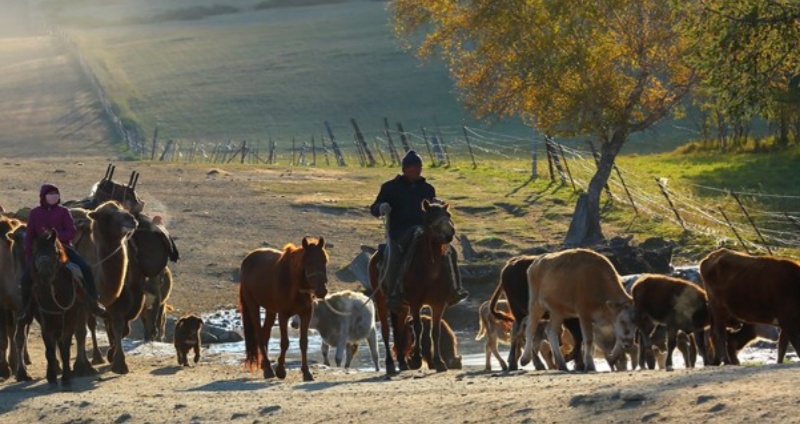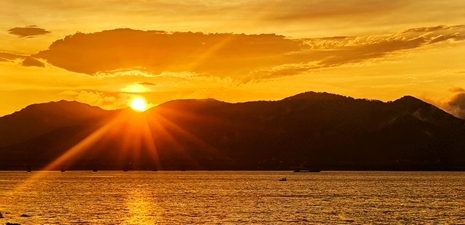
Chinese PresidentXi Jinpinginspects troops during the commemoration activities to mark the 70th anniversary of the victory of the Chinese People's War of Resistance AgainstJapanese Aggression and the World Anti-Fascist War, in Beijing, capital of China, Sept. 3, 2015. (Xinhua/Li Gang)
BEIJING, Sept. 3 (Xinhua) -- Thousands of Chinese troops, along with their counterparts from 17 countries, marched past Tian'anmen Square; tanks and armor vehicles mounted with drones and missiles rumbled by. They were saluted by military aircraft roaring overhead.
China put on a massive military parade Thursday to mark the 70th anniversary of the end of World War II and what it calls the Chinese People's War of Resistance against Japanese Aggression.
It was a picture-perfect parade to show the world how far the country has come after a bitter victory seven decades ago, and also how far it could go for its hard-won peace and order.
A PARADE FOR PEACE
In many ways, Thursday's parade - the 15th since 1949 and a part of China's larger WWII commemorations that have been in the run for months - was a first in the country. It was the first non-National day parade held by New China at the heart of Beijing, and the first to have invited foreign troops to march in it.
It was also China's first military parade observed by President Xi Jinping as the country's top leader.
On the Tian'anmen Rostrum where late Chinese leader Mao Zedong pronounced the birth of New China 66 years ago, Xi, dressed in a sharply cut, high-collared Mao suit, highlighted China's aspiration of peace.
"China will remain committed to peaceful development. We Chinese love peace. No matter how much stronger it may become, China will never seek hegemony or expansion. It will never inflict its past suffering on any other nation," said Xi.
Xi also announced in his speech that China will cut the number of its troops by 300,000.
The Chinese president was joined by dozens of heads of state and government as well as international organizations including UN Secretary-General Ban Ki-moon, Russian President Vladimir Putin, and Republic of Korea President Park Geun-hye.
The United States, Britain and France sent government representatives to attend the parade. Former German chancellor Gerhard Schroeder and former British prime minister Tony Blair were also present.
Their coming made the landmark event one with the widest foreign presence in the world among a series of V-Day commemorations.
The celebrations were set in motion by 70-gun salutes after Premier Li Keqiang announced its official opening.
The sun shone in a stunning blue sky, dispelling the last bits of the morning chill as well as the fatigue from more than 40,000 audiences who waited hours on roofless benches alongside the Chang'an Avenue.
Guards of honor marched on a red carpet that stretched between two Great Wall-shaped parterres in the Tian'anmen Square with huge signs that read 1945 and 2015, to raise the national flag to the March of the Volunteers - a popular wartime tune-turned national anthem - played by a 1,000-member military band.
"The victory of the Chinese People's War of Resistance Against Japanese Aggression is the first complete victory won by China in its resistance against foreign aggression in modern times," said Xi in his speech prior to the parade.
"This great triumph opened up bright prospects for the great renewal of the Chinese nation and set our ancient country on a new journey after gaining rebirth," Xi said in his about 10-minute address.
It's been 84 years since China was dragged into war following Japan's invasion of northeast China in 1931. In the fourteen years that followed, over 35 million soldiers and civilians were killed and injured in China, the main oriental theatre of WWII.
But the loss was not for nothing. Chinese archives revealed that over two thirds of Japan's ground forces were fought against in China during WWII.
Japan signed its formal WWII surrender on Sept. 2, 1945, and China celebrated its victory the following day.
"China's contribution and sacrifice during the Second World War is very much recognized, (China is) appreciated for all such sufferings, and sympathized by the world's people," UN Secretary-General Ban Ki-moon said last week in New York before traveling to China.
"It's important to look to the past, what kinds of lessons we have been learning, and how we can move ahead to a brighter future based on the lessons learned," he said.
A PARADE TO REMEMBER
As he reviewed the troops in a black open-top Red Flag limousine, Xi Jinping greeted his "comrades" from the People's Liberation Army (PLA) and the People's Armed Police who stood to attention down the length of Beijing's magnificent Chang'an Avenue.
"Follow the Party! Fight to win! Forge exemplary conduct!" over 10,000 servicemen and women saluted Xi and exclaimed.
At the height of the celebrations, helicopters carrying China's national flag and the PLA flag drew the curtains for the much-anticipated military parade. Another 20 choppers flew in a formation that spelt "70" in the air, followed by seven training aircraft trailing colored smoke.
On the ground, WWII veterans, chest bristling with medals, rode in convertibles amidst tides of applause.
From afar, the saluting veterans looked straightfaced but spirited. Only the occasional shake of hands, magnified on the big screens that stood on the two sides of Tian'anmen Square, betrayed their inner thrill.
Xi and all the other audience stood up as they passed by.
For many of the country's remaining WWII veterans, this anniversary could be the last they saw.
Ninety-five-year-old Zhang Yuanhe, in grey military uniform specially made for the parade, was gratified at the invitation to take part in the parade.
"It's a great honor," said Zhang who joined the Communist Party of China (CPC)-led Red Army at the age of 15.
More notably, veterans from counter-Japanese aggression forces led by CPC during WWII were joined in a Chinese military parade for the first time by their counterparts from the Kuomintang (KMT) forces who fought the same enemies 70 years ago.
Many of the KMT-led forces fled to Taiwan in 1949 after losing a civil war with the CPC. Confrontation between the mainland and the island in the following decades made it impossible for the two sides to acknowledge each other's contribution to the war.
The situation has begun to change in recent years with the improvement of relations across the Taiwan Strait.
Fu Longqian, 92, was among the KMT veterans invited to Thursday's celebrations.
"The country didn't forget us and it's a very high courteous reception," said the former artillerist who braved the gunfire of significant battles, including the Changsha Battle, the most time-consuming one between the KMT army and Japanese invaders that saw the largest-scale troops from both sides.
"It's the most memorable experience to fight against Japanese aggression in my life," he added.
A PARADE FOR UNITY
Excitement and thrill filled Tian'anmen Square as the PLA guards of honor and 10 foot formations - each named after a morale-boosting battle fought by Communist-led troops or Chinese war heroes and model combatants - marched by in impeccable synchrony and coordination.
Soldiers, drilled to perfection for months, barely blinked as they goosestepped past the Tian'anmen Rostrum in 128 carefully measured paces, each precisely 75 cm.
But the highlight for many of the 40,000 audience present and hundreds of millions more who watched the parade on television or via Internet was the first-ever participation of foreign troops in a Chinese military parade in Beijing.
Nearly 1,000 foreign troops from 17 countries marched at the heels of their PLA counterparts, drawing cheers and applause.
It was the first time that foreign troops had been invited to a Chinese military parade at the Tian'anmen Square.
Sara Imas in Shanghai was watching the live-show of military parade. The 65-year-old Jewish woman was born in Shanghai. Her parents came to the Chinese city in 1939. They were among 30,000 refugees who migrated from Europe during the war.
"Chinese put themselves in our position and offered help to us in the most difficult times," Imas told Xinhua. "So I am proud of the military parade."
Chinese people's empathy with Jewish refugees stemmed mostly from their own pains inflicted by the Japanese aggression.
China was the first country to face the onslaught of the Axis Powers in 1937, two years before Britain and France, and four years before the United States, Rana Mitter wrote in her 2013 book "Forgotten Ally."
But China's anti-fascist war began even earlier actually. On Sept. 18, 1931, Japanese army invaded northeastern China, marking the starting point of the Chinese people's courageous fight against fascism.
In the 14 years that followed, countries including the former Soviet Union and the United States among others, all came to China's aid in its struggle for national freedom.
A female medical soldiers' formation was named after Canadian surgeon Norman Bethune to honor his contribution to Chinese people's fight against Japanese aggressors.
Jay Vinyard, an allied pilot who flew supplies to Chinese forces over the Hump Route during WWII, said China's war commemorations were a rare chance for wartime pilots to meet again.
China and the United States should join hands to achieve peace and stability in the world, he said.
"All eyes are on the parade in Beijing," 22-year-old four-time Red Square parader Anton Mikhailov told Xinhua prior to the parade.
"Our parade on Red Square in Moscow and this parade in Beijing are both for the same things: to show that we remember our losses and our victory; to demonstrate our nations' strength; and to tell the world that the two allies that had fought shoulder to shoulder will join hands for a better future," he said.
A PARADE FOR FUTURE
The ground armament formations of the 70-minute parade include modules for ground combat, air defense and missile defense, maritime attacks, strategic strikes, communication support, and logistics and armament support.
This was the first time that the PLA arranged its armament based on their actual combat roles in a parade, said Peng Guangqian, deputy secretary-general of the Council for National Security Policy Studies.
"This indicates a change of the PLA training strategy, with more focus on actual combat," Peng said.
The parade included a host of China's home-made conventional and nuclear weaponry, which bespoke the PLA's long march from an army mainly composed of infantry to informationized military. Eighty-four percent of the 500 pieces of armament rolled out on Thursday had never been shown to the public before.
On display were China's Dongfeng-5B intercontinental strategic missiles designed to carry nuclear warheads, and the Dongfeng-21D anti-ship ballistic missiles described by some media as the "carrier killer."
Other cutting edge weaponry included the PLA's state-of-the-art tanks, unmanned aerial vehicles, and its new generation of airborne early warning and control aircraft, carrier-based fighters and attack helicopters which streaked low across the skies.
Among the armaments that were paraded in public for the first time were China's HJ-10 anti-tank missiles, HQ-12 anti-aircraft missiles and the third-generation carrier-based medium-long range air defense missiles.
Also in spotlight are China's shore-based anti-ship missiles which are capable of destroying large targets.
Experts believe that the high-profile weaponry display reflects the latest modernization of the Chinese armed forces, which was a result of the country's economic and technological progress.
The gleaming hardware rolling through posed a sharp contrast to China's poor weaponry in the wartime seven decades ago.
"In the fierce battle, the Japanese had rifles, tanks and fighter planes," veteran Hu Lidong said. "Our men were mowed down."
The parade was also inherently in line with the defensive strategy of the world's second largest economy.
A signatory of the Treaty on the Non-Proliferation of Nuclear Weapons, China has repeatedly vowed to adhere to the policy of no-first-use of nuclear weapons and the policy that it will, unconditionally, not use or threaten to use nuclear weapons against non-nuclear-weapon states and nuclear-weapon-free zones.
China is the only nuclear-weapon country that has publicly made the pledge.
"It's just like when you have a knife, you can use it either for offense or defense," said Chen Zhou, director of the National Defense Policy Research Center of the Academy of Military Sciences of China's People's Liberation Army. "It is your strategy behind that really matters."
China's latest white paper on military strategy issued this year underscored its principles of "defense, self-defense and post-emptive strikes."
The high-profile V-Day parade concluded at about 11:40 a.m., with some 70,000 white doves and 70,000 balloons released into the sky over Tian'anmen Square to make a symbol of peace.
Seventy years after the victory of the war, there are still few people ignoring historical facts, denying and even beautifying the invading history, which is sheer contempt of history, damage to international order and provocation to peace, an editorial published on Thursday's People's Daily said.
The parade will send a signal to the world to remember history and cherish peace, it stressed.
"I was not aware of how technologically advanced the Chinese army is (before I came here)," said Serbian formation leader Marko Marjanovic, adding that parades are a perfect way to commemorate countries' warring past.
"Serbian people cherish the tradition of (commemorating the end of) WWII. Our country, which was Yugoslavia at the time, was conquered by foreign occupying force and we also fought for freedom in the same way (as the Chinese)," Marjanovic said.
"We see the similarities in there... We see that our and the Chinese contribution was positive in WWII, and we want to maintain that tradition further on," he said.
Related:
Xi says Anti-Fascist War "a decisive battle" for justice
BEIJING, Sept. 3 (Xinhua) -- Chinese President Xi Jinping said Thursday the Chinese People's War of Resistance Against Japanese Aggression and the World Anti-Fascist War were "a decisive battle between justice and evil, between light and darkness, and between progress and reaction."
Xi made the remarks while addressing a gathering to commemorate the 70th anniversary of the victory of Chinese People's War of Resistance Against Japanese Aggression and the World Anti-Fascist War in downtown Beijing. Full Story
Spotlight: The message of China's V-Day parade
BEIJING, Sept. 3 (Xinhua) -- China, which won the war in the major oriental theater of the WWII, will stage Thursday an eye-catching military parade in the heart of its capital and in the presence of 30 heads of state and government leaders to mark the anniversary.
The scale of the grand ceremony, with a total of 12,000 troops and 500 pieces of military equipment to march through the Tian'anmen Square and nearly 200 aircraft to fly overhead in formations, has stirred up wild speculations, from a rising power wanting to flex its muscles to fortify its sphere of influence to Beijing fanning a smoldering antipathy toward Japan.Full Story
Commentary: China's V-Day parade underscores resolve to pursue peaceful development
BEIJING, Sept. 3 (Xinhua) -- The spectacular military parade China that is to be staged here Thursday carries many messages, yet all of them hail from one basic point: Beijing is steadfast in pursuing peaceful development.
Since China announced its plan to hold a military parade to mark the 70th anniversary of its World War II victory, wild speculations have emerged like that China's primary purpose is to flex its muscles at a time of heightened tensions in the South China Sea and with neighboring Japan.Full Story
Commentary: China's V-Day parade to recognize its contribution, sacrifice in WWII
BEIJING, Sept. 2 (Xinhua) -- China's grand military parade on Thursday, the country's first to celebrate the victory of World War II (WWII), will serve as a vivid reminder of China's irreplaceable contributions in the war and its inspiration to protect peace.
China, as the major Eastern battlefield of the WWII, had made great contributions to fighting against Japanese invaders and tremendous sacrifice to secure the victory.Full Story
Backgrounder: Military parades to mark victory of world anti-fascist war
Backgrounder: A review of military parades to mark end of WWII






